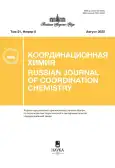Volume 51, Nº 8 (2025)
Articles
The influence of the steric factor on the structure of indium(III) iodide complexes based on substituted o-iminobenzoquinones
Resumo
A series of substituted o-iminobenzoquinones (6-((2,6-di-iso-propylphenyl)imino)-2,4-bis(2,4,4-trimethylpentan-2-yl)cyclohexa-2,4-dien-1-one (L1), 4-(tert-butyl)-6-((2,6-di-iso-propylphenyl)imino)-3-methoxycyclohexa-2,4-dien-1-one (L2), and 6-((2,6-di-iso-propylphenyl)imino)-3-methoxy-4-(2,4,4-trimethylpentan-2-yl)cyclohexa-2,4-dien-1-one (L3)) were used to synthesize indium(III) iodide complexes containing the redox-active ligand in its neutral form. The o-iminobenzoquinone L1 was synthesized for the first time. It was found that the structure of the obtained complexes depends on the degree of steric shielding of the carbonyl oxygen atom in the initial o-iminobenzoquinone. The sterically hindered ligand L1 forms a 1:1 adduct with InI3 (complex (L1)InI3 (I)). The absence of a substituent at the 2-position of the o-iminobenzoquinone ring promotes the formation of bis-ligand ionic derivatives {[(L2)2InI2]InI4} (II) and {[(L3)2InI2]InI4} (III). The molecular structures of L1 and the complexes I·0.5toluene, II·toluene·0.5hexane were determined by X-ray diffraction analysis (CCDC deposition numbers: 2440874 (L1), 2440875 (I·0.5toluene), 2440876 (II·toluene·0.5hexane)). The optical and electrochemical properties of the initial o-iminobenzoquinones and their corresponding indium(III) complexes were investigated. It was shown that complexation significantly enhances the oxidative properties of L1, L2, and L3.
 487-500
487-500


Design of an unsymmetrical PCN nickel(II) pincer complex based on 2,3,4,5-tetraphenyl-1-monophosphole
Resumo
A new unsymmetrical PCN pincer ligand, N-ethyl-N-(3-((2,3,4,5-tetraphenyl-1H-phosphol-1-yl)methyl)benzyl)ethanamine, combining different donors (amine and phosphole groups), has been synthesized. The ligand was obtained in four steps with a good overall yield (49%), using commercially available reagents as starting materials. Based on the obtained ligand, a design of an unsymmetrical nickel(II) pincer complex was proposed. Quantum-chemical calculations of the molecular structure of the complex show the formation of weak Ni–P bonds and the manifestation of a weak trans-influence of the phosphole group with respect to the amine group, which distinguishes this complex from its analogs, PCN complexes based on dialkylphosphines.
 501-509
501-509


Synthesis, structure, optical, and electrochemical properties of the chromophore cyclometalated iridium(III) complex
Resumo
A new N-donor ligand, methyl 4-(1-methyl-1H-perimidin-2-yl)nicotinate, and the corresponding octahedral cationic iridium(III) complex (1) were designed and synthesized. 1-Benzyl-2-phenyl[2,3]naphthimidazole was used as a cyclometalated ligand; PF6– served as a counterion. Compound 1 was characterized by 1H, 13C, 19F, 31P, 1H,1H-COSY, 1H,1H-NOESY NMR, high-resolution mass spectrometry and X-ray diffraction. As a result of the combination of ligands containing a large conjugated system around the metal ion, the target complex exhibits light absorption up to 700 nm (ε ~ 1000 M–1cm–1), translating in its deep color. Complex 1 demonstrates reversible electrochemical behavior at positive potentials with E1/2 = 0.58 V vs. EFc+/Fc. In terms of the key characteristics, the resulting compound surpasses most iridium analogs, and therefore appears promising for further testing in photovoltaic devices.
 510-518
510-518


Calcium complexes with a bulky tris-(2-N-piperidinomethyl)-phenyl)methoxide ligand. Synthesis and catalytic activity in the dearomatization of N-heterocycles
Resumo
The reaction of equimolar amounts of tris-((2-N-piperidinomethyl)-phenyl)methanol ((2-C5H10NCH2-o-C6H4)3COH) with [(Me3Si)2N]2Ca(THF)2 (toluene, 23○C) allows to obtain a mixed-ligand calcium alkoxide-amide complex [(2-C5H10NCH2C6H4)3CO]CaN(SiMe3)2 (I) in 70% yield. X-ray diffraction analysis showed that in I the monoanionic alkoxide ligand is coordinated to the metal in the κ3-O,N,N-fashion. Complex I catalyzes the addition of PhSiH3 to annelated N-containing heterocycles: quinoline, 4-methylquinoline, 6-methylquinoline and isoquinoline. The reactions are chemo- and regioselective and are completd within 24-120 hours. The reaction of I with PhSiH3 (molar ratio 1 : 2) leads to the formation of the bis(alkoxide) complex [κ2-O,N-(2-C5H10NCH2C6H4)3CO]2Ca (II) and CaH2, which are the result of symmetrization of the intermediately formed calcium alkoxyhydride complex. In the crystal, complex II has a nonlinear structure with an OCa(1)O angle of 112.65(4)○, and only one of the piperidine fragments of both ligands is coordinated to the metal ion. The molecular structure of complexes I and II was established using X-ray diffraction (CCDC № 2443979 (I), 2443980 (II)).
 519-528
519-528


Metalation of ketazines. Interaction of tetralone azine with methyLLithium
Resumo
The reaction of tetralone azine with methyllithium in tetrahydrofuran results in the release of 1 mol of CH4 and the formation of the lithium salt of enamine I, which crystallizes as a dimer in which the lithium atoms are bridges between the sp3- and sp2-nitrogen atoms of the two ligands and form a six-membered LiNNLiNN metallacycle (CCDC No. 2426300). Analysis of the electron density topology using the non-covalent interaction index and the source function allowed us to determine that each lithium atom in complex I interacts with the NNCC fragment of the ligand. The study of the charge distribution in the ligand anion demonstrated that the C(2) position is the most favorable for directing the attack of various electrophilic substrates. The DFT method showed that the process of phosphorylation of the deprotonated azine tetralone PCl3 is thermodynamically more favorable by 12.6 kcal/mol than the product of phosphorylation at the nitrogen atom.
 529-538
529-538











